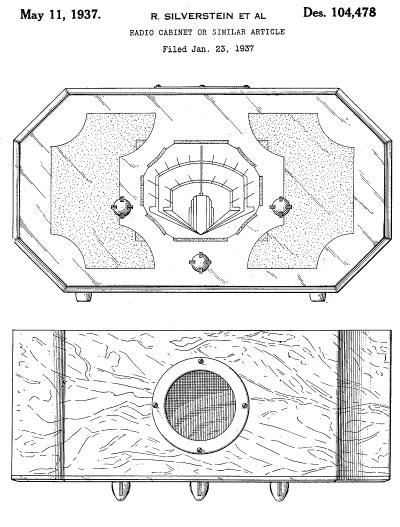|
Fantasy Radios-Design Patent Images 1930-1943 (Part 2) |
 |
|
To what was otherwise a fairly typical early 1930's mantle radio, this designer added a canopy that was intended to look like a band shell to project the sound from the upward-facing speaker out into the room. In doing so, he turned an attractive radio into an oddity. |
 |
|
This strange horseshoe-like console was designed for the Muzak corporation, the purveyor of the insipid background music that plagues elevator riders and supermarket shoppers throughout the land. I wasn't aware that they ever made standard broadcast receivers, but this is evidence that they considered it, however briefly. |
 |
|
Here's another "gas pump" radio with a strong deco flavor. |
 |
|
This one looks like a giant paper clip. I have no idea whatsoever what the two circular objects below the radio cabinet are meant to be. |
 |
|
Here's an elaborate ship's wheel radio that would look out of place on a ship, and out of place in your living room. Somehow, the designer's name is appropriate. I wonder if you turn the wheel to tune it? |
 |
|
While not an outstanding design, it looks like this guy was expecting Dick Tracy's wrist radio to become a commercial reality, so he thought he would try to cash in on it. Unfortunately, the technology of the mid 1930's hadn't quite caught up with the comic strips. |
 |
|
What a cool design for a console radio! It looks like something out of Flash Gordon, or a Fritz Lang movie. On the other hand, maybe a fire hydrant or trash can was the inspiration. I'm sure we'll never know for sure. |
 |
|
This is one of many mirrored radios that appeared during the 1930's. It featured a faux marble finish on the top and sides, and the glass front had frosted areas on either side of the dial. |
 |
|
Lamps that looked like the planet Saturn were produced during the 30's, so why not a loudspeaker? I guess no one agreed, though this would have been great as a remote jukebox speaker, especially if illuminated. Update: It turns out this unit was announced for sale in August, 1937 by the Colortone Acoustic Devices company of South Bend, Indiana. It was available with or without the ring, but there is no indication that it was illuminated. It could accommodate a 12 inch speaker and had a list price of $30. |
 |
|
As car radios became commonplace during the 1930's, designers began to come up with some very fanciful antennas for them. |
 |
|
This hexagonal console radio was never produced, but should have been. |
 |
|
Clunky and un-aerodynamic, this airplane radio featured "propeller" knobs in what would have been a Bakelite cabinet. It almost looks like some of the Crosley "dashboard" radios of the early 50's. |
 |
|
This great looking table model radio was designed for Stewart-Warner. |
| Back to Page 1 Proceed to Page 3 |
| Home |